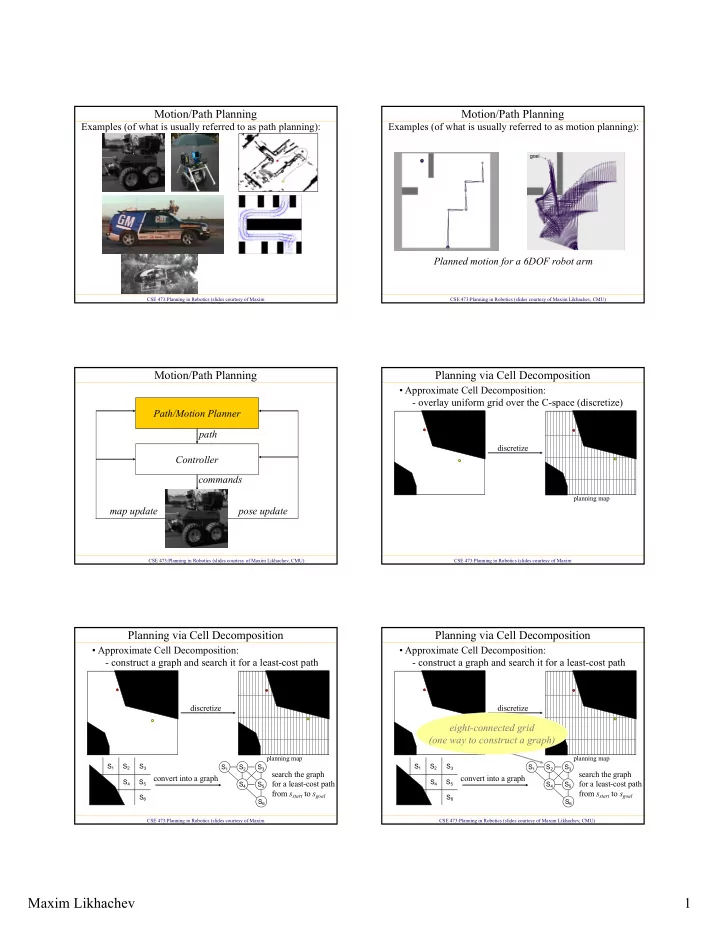

Motion/Path Planning Motion/Path Planning Examples (of what is usually referred to as path planning): Examples (of what is usually referred to as motion planning): Planned motion for a 6DOF robot arm CSE 473:Planning in Robotics (slides courtesy of Maxim CSE 473:Planning in Robotics (slides courtesy of Maxim Likhachev, CMU) Likhachev, CMU) Motion/Path Planning Planning via Cell Decomposition • Approximate Cell Decomposition: - overlay uniform grid over the C-space (discretize) Path/Motion Planner path discretize Controller commands planning map map update pose update CSE 473:Planning in Robotics (slides courtesy of Maxim Likhachev, CMU) CSE 473:Planning in Robotics (slides courtesy of Maxim Likhachev, CMU) Planning via Cell Decomposition Planning via Cell Decomposition • Approximate Cell Decomposition: • Approximate Cell Decomposition: - construct a graph and search it for a least-cost path - construct a graph and search it for a least-cost path discretize discretize eight-connected grid (one way to construct a graph) planning map planning map S 1 S 2 S 3 S 1 S 2 S 3 S 1 S 2 S 3 S 1 S 2 S 3 search the graph search the graph convert into a graph convert into a graph S 4 S 5 S 4 S 5 for a least-cost path for a least-cost path S 4 S 5 S 4 S 5 from s start to s goal from s start to s goal S 6 S 6 S 6 S 6 CSE 473:Planning in Robotics (slides courtesy of Maxim CSE 473:Planning in Robotics (slides courtesy of Maxim Likhachev, CMU) Likhachev, CMU) Maxim Likhachev 1
Planning via Cell Decomposition Planning via Cell Decomposition • Graph construction: • Graph construction: - lattice graph - lattice graph - pros: sparse graph, feasible paths outcome state is the center of the corresponding cell - cons: possible incompleteness each transition is feasible (constructed beforehand) action template action template replicate it replicate it online online CSE 473:Planning in Robotics (slides courtesy of Maxim CSE 473:Planning in Robotics (slides courtesy of Maxim Likhachev, CMU) Likhachev, CMU) Example Effect of the Heuristic Function • A* Search: expands states in the order of f = g+h values s start s goal Urban Challenge Race, CMU team, planning with Anytime D* CSE 473:Planning in Robotics (slides courtesy of Maxim CSE 473:Planning in Robotics (slides courtesy of Maxim Likhachev, CMU) Likhachev, CMU) Effect of the Heuristic Function Effect of the Heuristic Function • A* Search: expands states in the order of f = g+h values • Weighted A* Search: expands states in the order of f = g+ ε h values, ε > 1 = bias towards states that are closer to goal for large problems this results in A* quickly solution is always ε -suboptimal: running out of memory (memory: O(n)) cost(solution) ≤ ε ·cost(optimal solution) s start s start s goal s goal CSE 473:Planning in Robotics (slides courtesy of Maxim CSE 473:Planning in Robotics (slides courtesy of Maxim Likhachev, CMU) Likhachev, CMU) Maxim Likhachev 2
Effect of the Heuristic Function Effect of the Heuristic Function • planning in 8D ( <x,y> for each foothold) • Weighted A* Search: expands states in the order of f = • heuristic is Euclidean distance from the center of the body to the goal location g+ ε h values, ε > 1 = bias towards states that are closer to • cost of edges based on kinematic stability of the robot and quality of footholds goal 20DOF simulated robotic arm state-space size: over 10 26 states planning with R* (randomized version of weighted A*) joint work with Subhrajit Bhattacharya, Jon Bohren, Sachin Chitta, Daniel D. Lee, Aleksandr Kushleyev, Paul Vernaza planning with ARA* (anytime version of weighted A*) CSE 473:Planning in Robotics (slides courtesy of Maxim CSE 473:Planning in Robotics (slides courtesy of Maxim Likhachev, CMU) Likhachev, CMU) Heuristics Anytime Aspects CSE 473:Planning in Robotics (slides courtesy of Maxim CSE 473:Planning in Robotics (slides courtesy of Maxim Likhachev, CMU) Likhachev, CMU) Example, again Planning Examples Urban Challenge Race, CMU team, planning with Anytime D* CSE 473:Planning in Robotics (slides courtesy of Maxim Likhachev, CMU) CSE 473:Planning in Robotics (slides courtesy of Maxim Likhachev, CMU) Maxim Likhachev 3
Recommend
More recommend